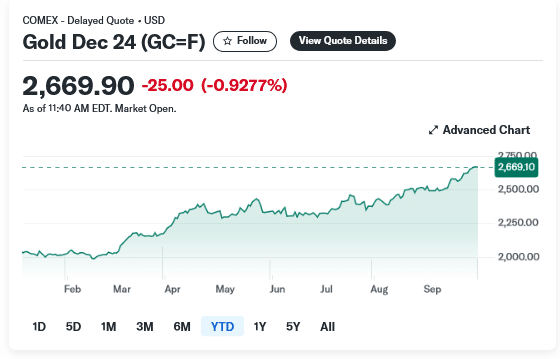Costco (COST) is slinging a lot of gold bars as prices for the yellow metal continue to surge.
Sales of gold were up “double digits” in the most recent quarter, Costco CFO Gary Millerchip told analysts on its earnings call Thursday evening. Millerchip went on to add that gold was a “meaningful tailwind” to e-commerce sales in the quarter.
Costco began selling gold bars in the fall of 2023. Wells Fargo analysts have estimated Costco is selling $100 million to $200 million in gold bars each month.
The most recent gold performance led to a tongue-in-cheek moment as Costco’s call was nearing its end.
Veteran Evercore ISI analyst Greg Melich asked executives, “Given the nonfood, the success there, … I’m just curious, are there any plans to maybe bring Kirkland Signature into the gold bullion market?”
Kirkland Signature is Costco’s large private-label business.
“No plans at this time,” Costco CEO Ron Vachris said.

The gold rush at the warehouse club comes as futures for the metal hit (GC=F) record highs at $2,708.70 an ounce during Thursday’s trading session. Year to date, gold is up 30%, with the Fed’s decision to cut rates by a half percentage point last week giving it another boost.
Top gold stocks such as Freeport McMoRan (FCX) and Barrick Gold (GOLD) have gained a cool 22% and 18%, respectively, in 2024.
On its website, Costco sells its 1 oz gold bar for $2,679.99. You have to be a member to buy the bullion. It’s also non-refundable, and there’s a limit of five total units per membership.

IDX CIO Ben McMillan told Yahoo Finance this week that after years of gold being “sleepy,” it’s now firing on all cylinders as investors look to de-risk their portfolios.
“Gold historically has been … kind of associated with very risk-off, very flight to safety type trades like hard landing recessions,” McMillan said.
Despite the hefty sales of gold, Costco’s bread and butter is still hawking products like, well, bread and butter to cost-conscious shoppers.
Its fiscal fourth quarter same-store sales growth came in at 6.9%, compared to estimates of 6.4%. E-commerce sales jumped 19.5%, slightly lower than the 19.63% growth rate Wall Street was projecting.
Sales were powered by growth in appliances, food health and beauty aids, tires, toys, and gift cards, among other items.
Read the full article HERE.


